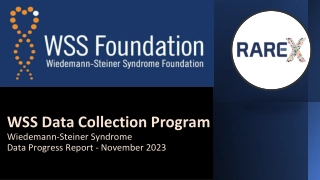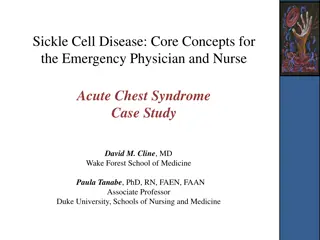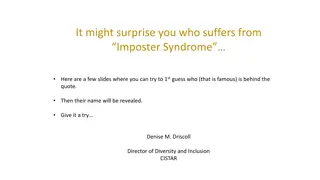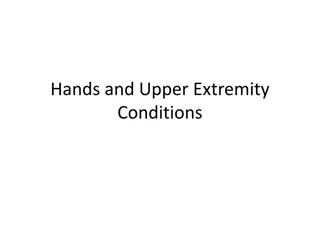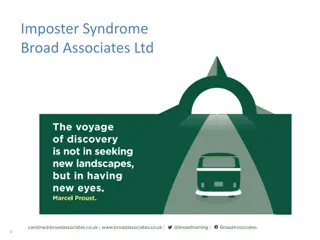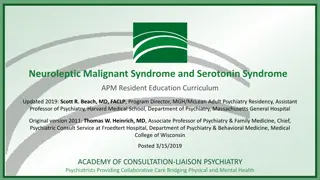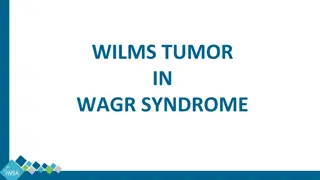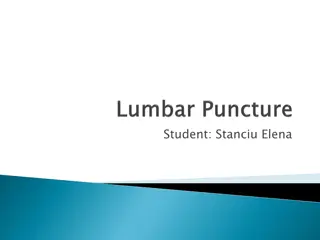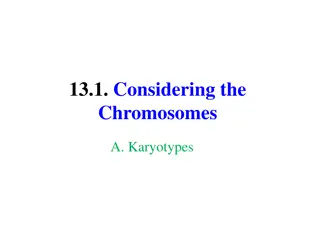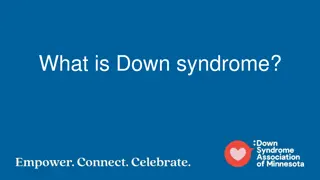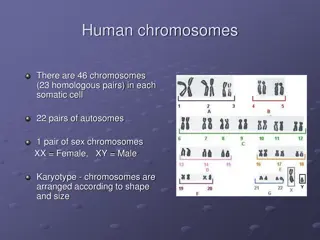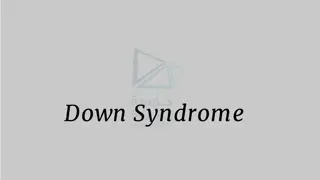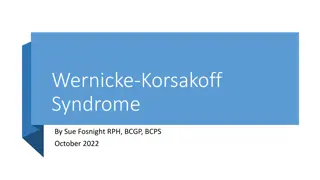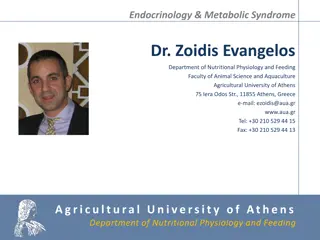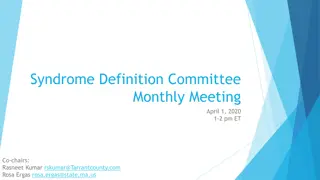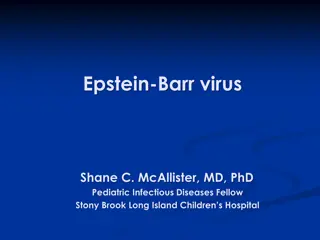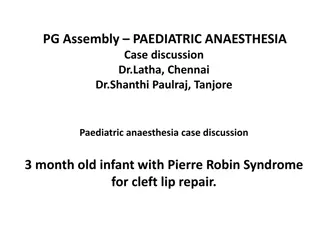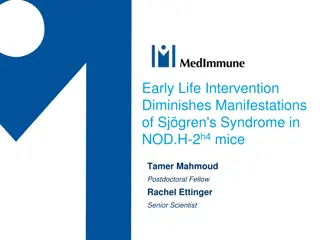Guillain-Barré Syndrome
Guillain-Barré Syndrome (GBS) is a monophasic disease affecting the PNS, often triggered by antecedent infections. Clinical manifestations include ascending paralysis, sensory disturbances, and autonomic involvement. Hospitalization and ventilatory assistance may be required, with most patients experiencing a plateau in symptoms within 4 weeks of onset.
Download Presentation

Please find below an Image/Link to download the presentation.
The content on the website is provided AS IS for your information and personal use only. It may not be sold, licensed, or shared on other websites without obtaining consent from the author.If you encounter any issues during the download, it is possible that the publisher has removed the file from their server.
You are allowed to download the files provided on this website for personal or commercial use, subject to the condition that they are used lawfully. All files are the property of their respective owners.
The content on the website is provided AS IS for your information and personal use only. It may not be sold, licensed, or shared on other websites without obtaining consent from the author.
E N D
Presentation Transcript
Guillain-Barr syndrome (GBS) is a monophasic disease involving only myelinated nerves in the PNS. The inflammatory appears to be due to an immune-mediated attack of peripheral myelin. most common demyelinating form (>80%) polyneuropathy , called acute (AIDP), Acute motor axonal neuropathy (AMAN) is more severe clinically than AIDP. The immune attack in AMAN appears directed against the PNS myelinated axon exposed at the node of Ranvier. The annual incidence of GBS about 1 to 2 cases per 100,000 persons. The incidence increases with age, and males slightly predominate.
Pathophysiology GBS occurs in the setting of an antecedent illness in about 60% of patients. Upper respiratory and gastroenterological infections are frequent, with the most (cytomegalovirus and Epstein Barr) (Campylobacterjejuni). common being and viruses bacteria It is proposed that via molecular mimicry the patient develops an immune response against the infecting agent that cross-reacts with antigens on the patient s peripheral nerve myelin or axons.
Clinical Manifestations GBS manifests as rapidly evolving areflexic motor paralysis with or without sensory disturbance. The usual pattern is an ascending paralysis. Weakness typically evolves over hours to a few days and is frequently accompanied by tingling dysesthesias in the extremities. The legs are usually more affected than the arms, and facial diparesis is present in 50% of affected individuals. The lower cranial nerves are also frequently involved, causing bulbar weakness with difficulty handling secretions and maintaining an airway. Pain in the neck, shoulder, back, or diffusely over the spine is also common in the early stages of GBS, occurring in ~50% of patients.
Most patients require hospitalization, and almost 30% require ventilatory assistance at some time during the illness. Deep tendon reflexes attenuate or disappear within the first few days of onset. Cutaneous sensory deficits (e.g., loss of pain and temperature sensation) are usually relatively mild, but functions subserved by large sensory fibers, such as deep tendon reflexes and proprioception, are more severely affected. Once clinical worsening stops and the patient reaches a plateau (almost always within 4 weeks of onset), further progression is unlikely.
Autonomic involvement is common and may occur even in patients whose GBS is otherwise mild. The usual manifestations are loss of vasomotor control with wide fluctuation in blood pressure, postural hypotension, and cardiac dysrhythmias. Pain is another common feature of GBS; in addition to the acute pain described above, a deep aching pain may be present in weakened muscles that patients overexercised the previous day. Other pains in GBS include dysesthetic pain in the extremities as a manifestation of involvement. liken to having sensory nerve fiber
Variants AMAN is a variant of GBS. There is motor axonal degeneration and little inflammation. Despite the axonal involvement, recovery is similar to the demyelinating form. or no demyelination or The Miller Fisher syndrome: is characterized by gait ataxia, areflexia, and ophthalmoparesis. It is considered a variant of GBS because; it is often preceded by respiratory infection, it progresses for weeks and then improves, and CSF protein content is increased. There is no limb weakness, however, and nerve conductions are generally normal.
Major Laboratory Findings Major blood tests are normal. The CSF becomes abnormal during the first week. CSF protein elevates to levels of 100 to 400 mg/dL but, CSF has a normal glucose (albuminocytological dissociassion). level and normal WBC count Neuroimaging of the spinal cord should be normal. Nerve-conduction study results become abnormal in AIDP by the end of the first week. conduction blockage in the majority of motor axons. The motor nerve conduction velocity reduces, reflecting the segmental demyelination. Variable evidence of muscle electromyography beginning after 2 to 3 weeks. denervation may be found on
Principles of Management and Prognosis The key to successful management is excellent nursing care. Patients placement in a critical care setting. About 1/4 of patients require a ventilator. usually require hospitalization and Cardiac monitoring is recommended because patients may be prone to severe arrhythmias that may require electrical medication. cardioversion and
Plasmaphoresis or human immune globulin is beneficial if given early in the course of AIDP. Both equally shorten the time to recovery and likely prevent progression of disease to more severe stages. In contrast, use of corticosteroids is not beneficial. During improves function. recovery, physical therapy often
In mild cases of AIDP, motor recovery can occur over a few weeks. For AIDP patients who cannot walk, ambulation often takes 4 to 6 months. In severe cases, recovery may continue for up to 2 years. In AIDP, about 85% of patients fully recover and 15% are left with minor sequelae such as loss of reflexes. Death following cardiac arrhythmias or infectious complications still occurs in 2% to 3% of patients with GBS.
Bells palsy or idiopathic peripheral facial nerve palsy is the most common cause of CN VII dysfunction. It has an equal sex distribution. Cases occur in all ages, but the incidence increases with age. It is rare for Bell s palsy to be bilateral or to recur.
Pathophysiology The pathogenesis of Bell s palsy remains poorly understood. MRI and pathologic studies show the facial canal as the site of pathology. The nerve becomes edematous with varying amounts of surrounding inflammation. Early theories suggested ischemia to the facial nerve led to nerve edema and nerve compression from the walls of the facial canal. Later, the ischemia concept was dropped and the nerve edema was considered idiopathic. Recently, viral infection theories have focused on varicella- zoster and herpes simplex viruses as potential viruses that reactivate in the facial nerve to cause nerve damage, edema, and inflammation.
Major Clinical Features The onset of Bell's palsy is fairly abrupt, maximal weakness being attained by 48 h as a general rule. Pain behind the ear may precede the paralysis for a day or two. Complete interruption of the facial nerve paralyzes all muscles of facial expression, The corner of the mouth droops, the creases and skin folds are effaced, the forehead is unfurrowed, and the eyelids will not close. Upon attempted closure of the lids, the eye on the paralyzed side rolls upward (Bell's phenomenon).
The lower lid sags and falls away from the conjunctiva, permitting tears to spill over the cheek. Food collects between the teeth and lips, and saliva may dribble from the corner of the mouth. The patient complains of a heaviness or numbness in the face, but sensory loss is rarely demonstrable. Taste hyperacusis may be present. sensation may be lost unilaterally, and
Differential Diagnosis There are many other causes of acute facial palsy that must be considered in the differential diagnosis of Bell's palsy. Lyme disease can cause unilateral or bilateral facial palsies. Ramsay Hunt syndrome, caused by reactivation of herpes zoster in the geniculate ganglion, consists of a severe facial palsy associated with a vesicular eruption in the external auditory canal. in sarcoidosis and Guillain-Barr syndrome Facial palsy is often bilateral. Acoustic neuromas frequently involve the facial nerve by local compression. Infarcts, demyelinating lesions of multiple sclerosis, and tumors are the common pontine lesions that interrupt the facial nerve fibers; other signs of brainstem involvement are usually present.
All these forms of nuclear or peripheral facial palsy must be distinguished from the supranuclear type. In the latter, the frontalis and orbicularis oculi muscles are involved less than those of the lower part of the face, since the upper facial muscles are innervated by corticobulbar pathways from both motor cortices, whereas the lower facial muscles are innervated only by the opposite hemisphere. In supranuclear lesions there may be a dissociation of emotional and voluntary facial movements and often some degree of paralysis of the arm and leg, or an aphasia (in dominant hemisphere lesions) is present
Major Laboratory Findings Remarkably few laboratory abnormalities exist in Bell s palsy. The patient has a normal sedimentation rate, and serum electrolytes. hemogram, erythrocyte The CSF is normal. If the CSF has a pleocytosis, the facial palsy etiology is likely due to an inflammatory or infectious process, such as varicella-zoster virus, Lyme disease or sarcoidosis. Cranial MRI with gadolinium may show enhancement of the facial nerve within the facial canal. The EMG, normal for the first 3 days, shows a steady decline in activity and after 10 days, denervation potentials begin to appear.
Principles of Management and Prognosis Symptomatic measures include: (1) the use of paper tape to depress the upper eyelid during sleep and prevent corneal drying. (2) massage of the weakened muscles. A course of glucocorticoids, given as prednisone 60 80 mg daily during the first 5 days and then tapered over the next 5 days, appears to shorten the recovery period and modestly improve the functional outcome. combination therapy with prednisone plus valacyclovir (1000 mg daily for 5 7 days) may be marginally better than prednisone alone, especially in patients with severe clinical presentations.
If there is incomplete paralysis of facial muscles, there is an excellent prognosis for full to satisfactory recovery that spontaneously occurs within 2 months. Should the facial paralysis be complete, full to satisfactory recovery spontaneously occurs in about 80% of patients over 1 to 3 months.
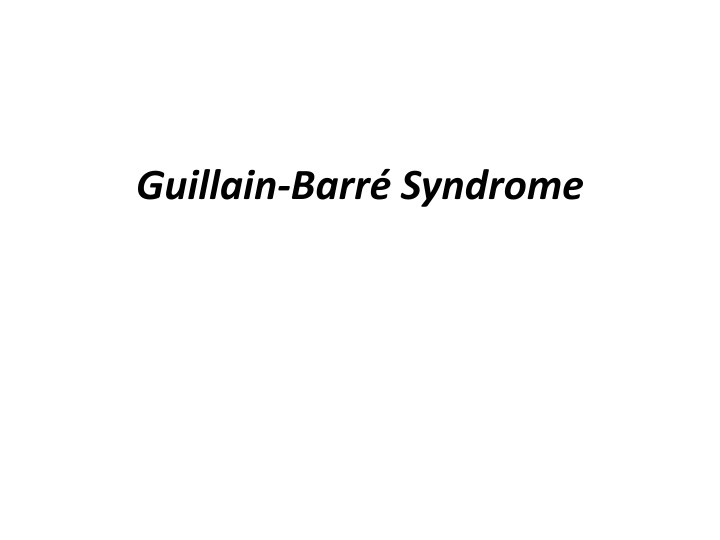

![❤[PDF]⚡ Zee Zee Does It Anyway!: A Story about down Syndrome and Determination](/thumb/20462/pdf-zee-zee-does-it-anyway-a-story-about-down-syndrome-and-determination.jpg)
